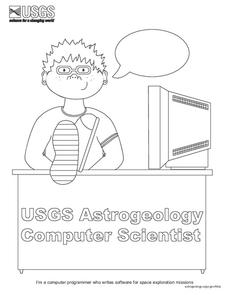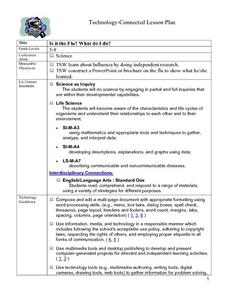Houghton Mifflin Harcourt
Frog Dissection
Guide your learners through the process of opening up a frog. The resource provides step-by-step instructions for dissecting a frog, as well as guiding questions to answer throughout the lab.
Science Matters
Landforms from Volcanoes
Three major types of volcanoes exist: cinder cone, composite/strata, and shield. The 18th lesson in a 20-part series covers the various landforms created from volcanoes. Scholars work in pairs to correctly identify the three types based...
Cornell University
Insect Anatomy
Young entomologists discover insect anatomy in a very detailed unit plan. Offering background information for teachers about various insects, class members explore the differences between bugs and insects—and yes, there are many...
Chicago Botanic Garden
Causes and Effects of Climate Change
It's time for your class to literally show what they know! Pupils illustrate what they learned about the causes and effects of climate change by filling out a graphic organizer to complete the 5-part series of lessons. They discuss them...
Millennium Schools
Lifestyle Chemistry
My name is Bond, Hydrogen Bond. Written for distance scholars working on chemistry at the high school level, the lesson includes eight weeks worth of material divided into six parts: substances you use, mixing it up, your skin, what's...
Laboratory for Atmospheric and Space Physics
Star Light, Star Bright
Star light, star bright, first star I see ... wait a minute, where did the star go? Scholars complete a simulation that measures the brightness of a distant star as another object passes in front of it. Learners move the passing object...
Channel Islands Film
Human Impact on the Food Web of Santa Cruz Island
What happens when a non-native species is introduced onto an island? Santa Cruz Island, part of the Channel Island chain located off the coast of southern California, provides the perfect laboratory for young environmental scientists to...
Channel Islands Film
Santa Cruz Island - Visible Thinking Routines
Visible Thinking Routines are designed to help learners deepen their understanding of what they are learning and enable them to communicate their understanding of concepts to others. Individuals adopt one of these routines to use to...
Channel Islands Film
Santa Cruz Island Restoration Narrative
What would you be willing to do to save an animal from extinction? After re-viewing a video about the restoration of the Island Fox on Santa Cruz Island, individuals adopt the point of view of one of the key players in the debate and...
Channel Islands Film
Santa Cruz Island - Writing for Information
After re-viewing a documentary segment on the restoration of Santa Cruz Island,, individuals craft an essay in which they compare the views of the various stake holders featured in the video and identify the point of view they find the...
Channel Islands Film
Island Rotation: Lesson Plan 2
Why are Torrey pines only found in La Jolla, California and on Santa Rosa Island? Class members examine images of Torrey pines from these two locations, noting the similarities and differences, and then develop a demonstration model that...
Curated OER
Landforms Slideshow
Students identify twelve different types of landforms, and create a slideshow about each landform that includes a title, pictures, definitions, conclusions and a reference page.
Curated OER
Habitats Activity
In this habitat activity, students identify and sort the animals in a box of animal crackers to the habitats to which they belong and then create a graph to document how many animals fit into each habitat.
Curated OER
USGS Astrogeology Computer Scientist
In this coloring worksheet, students will color a picture of a kid sitting with his feet up on a desk. The desk says, "USGS Astrogeology Computer Scientist." There is a description of the job title at the bottom of the page.
Curated OER
No Title
Sixth graders, after reviewing and studying the basics of recording, analyzing and presenting data, create on graph paper a bar or line graph to represent given data and then interpret the data. They answer questions about the given data...
Curated OER
How Cell Phones Work
Fifth graders are introduced to the text, LITERACY LINE viewing the contents page. They review the definition of explanatory writing; discussing the features used and complete a KWL chart to identify what they already know about how a...
Curated OER
Is It The Flu? What Do I Do?
Students use the internet to research the flu. Using various websites, they identify who should get flu shots, how to protect themselves and guidelines for getting over the flu. They write a one page report on their findings to end the...
Curated OER
Visualizing Trees
students draw what they visualize after the teacher reads a page from the book Oak Trees. They share their pictures and compare how they visualized the tree being described.
Curated OER
Life Cycle of the Butterfly
Young scholars observe and analyze the life cycle and metamorphosis of the Painted Lady Butterfly. They write observation journal entries three times a week and summarize what they observed. Using KidPix computer software they create...
Curated OER
Label the Butterfly Life Cycle Diagram
In this science instructional activity, students study the life cycle of a butterfly by first reading the information on the page. Students then label a life cycle diagram and read 4 definitions of important words.
Curated OER
Always Pointing North
In this magnetic compass reading comprehension worksheet, students read brief 2 page selection and then answer 6 multiple choice questions.
Curated OER
2nd Grade - Act. 26: It Looked Like...
Second graders read book, It Looked Like Spilt Milk, and create page in class book.
Project SMART
Rocks and Minerals: Touch the Earth
Students complete a unit of lessons on rocks and minerals. They conduct research, write e-mail questions to geologists, write daily journal entries, label maps demonstrating types of rocks/minerals found, and create a web page that...
Curated OER
THE FOODS WE EAT
Young scholars discuss the five food groups and the seven basic nutrients. They decorate Food We Eat booklet pages with pictures of foods found on background, rubber stamp and animation tools in KidPix. (Booklet has a page for each food...
Other popular searches
- Title Page of Book
- Desert Title Page
- Spine Title Page
- Glossary Index Title Page
- Genre Title Page
- Creating a Title Page
- Glossary, Index, Title Page
- Journal Writing Title Page
- Index and Title Page
- A Book's Title Page
- Library Title Page
- Writing Workshop Title Pages

























